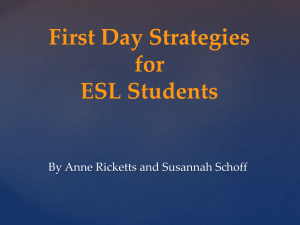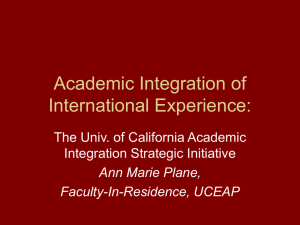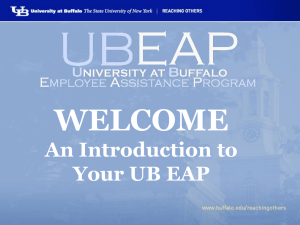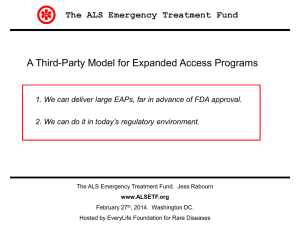Levels 1 - Thompson Rivers University
advertisement
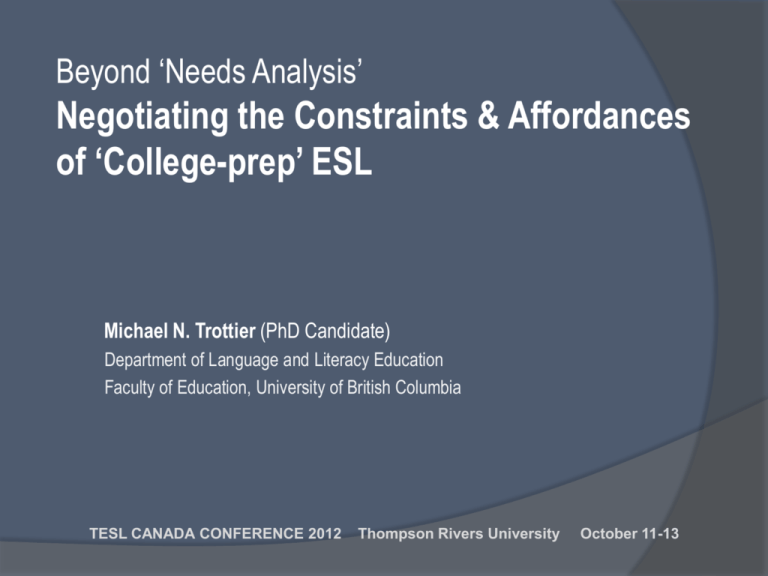
Beyond ‘Needs Analysis’ Negotiating the Constraints & Affordances of ‘College-prep’ ESL Michael N. Trottier (PhD Candidate) Department of Language and Literacy Education Faculty of Education, University of British Columbia TESL CANADA CONFERENCE 2012 Thompson Rivers University October 11-13 Guiding research Qs Q1 What is the purpose of ‘College-prep’ ESL, how is it structured? Q2 How are the program’s resources (e.g., curricular, instructional) used to socialize learners into new academic practices? Q3 How do learners take up/respond to intense EAP practices (e.g., teaching, assessment) across program levels? Theoretical frameworks 1. Globalization and postsecondary education (Levin, 2002; Ninnes & Hellstén, 2005; Singh, 2005) 2. Second language socialization (SLS) (Duff, 2003, 2010; Zuengler & Cole, 2005) 3. Critical applied linguistics (CALx) (Pennycook, 1997; Benesch, 2001; Hyland, 2006; Belcher, 2009) Second language socialization (SLS) Origins SLS - based on early LS scholarship, which focused on research in L1 socialization (Ochs & Schieffelin, 1984; Schieffelin & Ochs, 1986) - takes a holistic ‘social practices’ approach to language learning = language is constitutive of social life & identity - concerns the process whereby non-native speakers of a language seek greater access & participation in those linguistic practices which lead to membership in target (desired) L2 communities (Duff, 2003, 2010) - poses “particular challenges for...transnational sojourners who may have …complex histories, conflicted identities, and often uncertain trajectories and/or investments in the target language and its communities” (Duff, 2010: 5) = contingency & variability in L2 learning process/outcomes An ethnographic, multi-case look at EAP Study design - ethnographic, multiple case study (6 focal + non-focal subjects) - 1-year in duration (intensive EAP + transitions to regular programs) Data sources - classroom observation/field notes (general + critical events) - participant-generated texts (assignments, projects, evaluations) - course syllabuses and evaluations (e.g., rubrics, feedback) - one-on-one, semi-structured interviews (+ focus groups) (triangulated) Analysis ‘emic’ perspective - grounded, reflexive (constructionist) approach to data - thematic/discourse analysis: positioning, identity, attribution theory, etc. “What is going on here? - emphasis on participant-driven views (Ss + teachers + me) - an alternative, bottom-up view of ‘Needs Analysis’ EAP as a form of L2 socialization A Social Practices Approach MACRO General educ. discourse & institutional policies - globalization, marketing - ideologies of L2, culture EAP Practices Teaching: content choice/ MICRO - group/pair interaction - communicative events - mutual scaffolding - learning strategies control of texts, cultural content, scaffolding, etc) Assessment: feedback.., power/knowledge, etc. The ‘whats’ of EAP Main curricular features & focal activities Levels 3-4 • .Introductory ESL …- everyday English comm. ....- supportive classroom ....- varied levels of literacy •.. Levels 1-2 • Introduction to EAP - Speaking (survey project/PP) - Listening(TED, notetaking ) - Writing (sentence structure, ..TS, 3-7 paragraphs essay) - Reading (academic word list, ..business/tech/globaliz. articles) •Intense EAP - Speaking (corporate sim, ...survey project, PPoint ...presentation & response) - Listening (notetaking/main ...ideas, summary + response) - Reading (scan/skimming, .. ...summary/response, notes) - Writing (vocab in context, .. ..+major research paper: ….locating sources, quoting/ ….paraphrasing, essay outline . ………………. Levels 5-6 Saudi/Chinese representation across programs levels N =1924 (2011 program intake) Saudi Chinese 60% 50% 40% 54% 49% 48% 44% 39% 33% 30% 23% 20% 10% 5% 4% 0% Level 1 L-2 L-3 L-4 L-5 L-6 (50/60%) (60/70%) M: Are there certain kinds of students, certain sociocultural backgrounds which are better suited to this kind of intensive ESL program. (1.7) And I’ll invite you to respond to each other’s answers as well (interviewees discuss turn-taking) T1: → °all right° (1.2) My- my impression is that ehm::: there are certain (.) what did you call them, sociocultural groups, that tend to do better in certain skill areas. Um- One of the things that I’ve noticed is that students who::: who come from Middle-Eastern backgrounds tend to do better, uhm, especially in speaking skills areas. (.9) Uhm (.6) and tend not to do so well in- in things l like writing. That’s just (.5) [my] overall view of being here for 2 years now and looking at the usual range of outcomes. T2: → Yeah I would agree with that, and it- I believe it reflects their own educational background (.) in their own (.) language even, that there’s not as much emphasis on .hhhh reading and’uh writing as- from what I’ve gathered f- ( ) from talking to the students .hhh And it- it bears itself out in the number of- (.) uhm, Arabic students:: Arabic speaking students who finally graduate from Level 6. It’s a- (.8) much smaller % than (.) the numbers that (.) begin the program M: T2: M: T2: M: T2: You mentioned that you had seen two:: (.) Saudi m::ales or fe- females= =females= =at Level 6 at some point. Yes:: (.) (unequivocally) who were both quite successful. And [how many times had you taught Level 6. [But F:our. Four. Had you heard of other cases? Um:: no, I’m- that’s just my own (.) [observation of ( ) [yeah and yourself (to T1)? .hhhhh Um: I only ever ONCE had a Saudi student when I was teaching Level 6 M: T2: M: T1: Saudi/Chinese academic trajectories across levels N =1924 (2011 program intake) Saudi Chinese 60% 50% 40% 54% 49% 48% 44% 39% 33% 30% 23% 20% 10% 5% 4% 0% Level 1 L-2 L-3 L-4 L-5 L-6 (50/60%) (60/70%) Participant profiles (N = 6) *Name sex/age nation education EAP experience Current program _______________________________________________________________________________________________________________________________________________________________________________________ ASSEER M-22 S/Arabia Business Rep. L4, L6 Rdg P/T (Business/Finance) ARCHIE M-26 *China Business Rep. L5 X2, L6 Writg P/T (Architecture) JACK M-19 *China High school Repeating L6 Business (Jan/13 start) MANDY F-20 *China High school ------ Business//Finance BENJIE M-22 *China High school Rep. L6 Writing Engineering SEAN M-40 Korea Electrical Eng Repeated L6 Engineering _____________________________________________________________________________________ Kadrye F-23 Turkey B.A . Int’l Relations (Business) Completed 6 (returned home) Shamsi F-22 S/Arabia Medical (Business) Completed 6 (changed schools) * Names and other information has been made anonymous to protect individual/program identities Q: How do different learners respond to intense EAP? N =1924 (2011 intake) Saudi Chinese 60% 50% 40% 54% 49% 48% 44% 39% 33% 30% 23% 20% 10% 5% 4% 0% Level 1 L-2 L-3 L-4 L-5 L-6 (50/60%) (60/70%) The ‘hows’ of intensive EAP: Access & participation (LS perspective) “[Access and participation]…lies at the core of Language Socialization (LS) studies as well as other alternative approaches to SLA” (Duff & Talmy 2011:104, ref to Ortega 2009) (SLA perspective) “ …the influence of broader macrosocial and cultural processes should not be underestimated in either cognitivist SLA or language socialization. After all, current mainstream SLA theory holds that opportunities for appropriate input/ intake, interaction, and output, plus feedback of particular types, are indispensable for SLA.” (ibid.) Access → Participation → Assessment → Access Participation • input • intake Access • roles, genres • mono/dialogic activities Evaluation Assessment Reading Comp: Gap-fill & paraphrase Asseer Archie The ‘whats’ of EAP Main curricular features & focal activities Levels 3-4 • .Introductory ESL …- everyday English comm. ....- supportive classroom ....- varied levels of literacy •.. Levels 1-2 • Introduction to EAP - Speaking (survey project/PP) - Listening(TED, notetaking ) - Writing (sentence structure, ..TS, 3-7 paragraphs essay) - Reading (academic word list, ..business/tech/globaliz. articles) •Intense EAP - Speaking (corporate sim, ...survey project, PPoint ...presentation & response) - Listening (notetaking/main ...ideas, summary + response) - Reading (scan/skimming, .. ...summary/response, notes) - Writing (vocab in context, .. ..+major research paper: ….locating sources, quoting/ ….paraphrasing, essay outline . ………………. Levels 5-6 ‘Needs Analysis’ from below What KIND of Access & Participation are possible? What does (should?) it mean to “learn a language” 1- What are the ‘costs’ of intense ‘decontextualized’ EAP? 2- how to move beyond a largely ‘skills’ orientation to EAP? 3- negotiation of otherwise ‘fixed’ (academic) linguistic meaning (NofM) 4- participation as ‘investment’ in emerging L2 identities (Norton 2000) 5- opportunities to share/explore (multi)cultural themes academically The Six Thinking Hats White Hat Black Hat Focuses on data, facts, information known or needed. Focuses on potential difficulties, why something may not work. Red Hat Focuses on feelings, hunches, gut instinct, and intuition. Yellow Hat Focuses on values and benefits. Why something may work. Green Hat Focuses on creativity: possibilities, alternatives, solutions, new ideas. Blue Hat Focuses on manage the thinking process, focus, next steps, action plans. The Cost of Intensity: Feedback & scaffolding Level/learner assignment feedback type/source ----------------------------------------------------------------------------------------------------------------------------------------------------------------------------------------------------------------------------------------------------------------------------------- L-4 ‘Jack’ multi-paragraph essay holistic (rubric) & written L-4 ‘Jack’ interactive survey Qs survey team (+instructor ) L-6 ‘Sean’ major research paper written (week 6 of 7, draft #1) Access Assessment Asseer, on the challenges of Level 4 - part of a 25-member cohort of Saudi men, 90% of whom failed L4 - special group sponsored by the Saudi government (max. 1.5 yrs) - admitted based on 2.5 yrs of college in KSA, *Accommodation: All eventually passed L4, and are now receiving extra coursework in Reading & Writing (L5) *Archie – on the program’s Chinese-style speaking competition - on the value of `partial marks` in grading (reading comp) *Jack - on the affective impact of neg. instructor feedback (L4 Writing) Participation *Archie – on cultural content, `Anything but Chinese` classmates *Saudi Focus Group - on the for social ‘costs’ of intensive EAP *Asseer - on the mix of Saudi & Arab students in classes - on his lack of fluency and desire to be casual in English Identity and Desire *Archie - Change in career options (Architectural Mgmt → Chef) Presentation goals 1 Context Post-secondary, intensive EAP 2 Theoretical framework/methodology (Second) Language Socialization 3 Case study data Qualitative interviews (individual, focus groups) ‘Needs analysis’ and the disembodied learner? “…SLA research has traditionally given more attention to the process of acquisition than to the flesh-and-blood individuals who are doing the learning” (p. 2) “Success in language learning is an artifact of schooling, of the need for institutions to demarcate those who know from those who don’t, but the language learning experience itself is neither successful nor unsuccessful. It can be lived more or less meaningfully, no matter what level of proficiency has been attained” (p. 4) Claire Kramsch (2006) The Multilingual Subject: What Foreign Language Learners Say about their Experience and Why it Matters Instructor’s email reply, following receipt of student’s email + attachment Hello Archie, First of all, never just attach a document to me through email without writing me a polite note. You can follow the format of my email to you to learn to write a proper email. Just use the letter format. Please find attached my feedback. Regards, Beyond ‘Needs Analysis’ Negotiating the Constraints/Affordances of ‘College-prep’ ESL Thank you! Michael N. Trottier meetmnt@interchange.ubc.ca * Special thanks to my research committee, Drs Patsy Duff, Steven Talmy, and Bonny Norton, for their inspiring work & ongoing guidance. The ‘hows’ of intensive EAP Access & participation Role of the social • Culture as a resource • Motivational aspects Scaffolding • feedback practices • cognitive load Role of assessment • discrete L2 ‘skills’ • role of assessment


